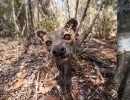The Fossa, a rare carnivore native to Madagascar, It is the largest predator of the island. With only 2500 surviving individuals, It is considered one of the most endangered species in the world.
The fossa is an animal of the family of the Mongoose, with a length of almost 2 meters from snout to the tip of the tail and a weight of up to 12 kg.
Reserved, like a cat, they are expert climbers and well-equipped to pursue the lemurs in the forest, hunting down even the largest of the lemur species.
On the island of Madagascar, the fossa is the largest carnivore and is in fact the largest predator on the entire island. As predator eats practically everything, from lemurs to wild pigs and poultry. Unlike its cousin the Mongoose, this species has many characteristics that make it look like a cat, such as retractable claws and sharp teeth. It has a reddish brown layer and its snout is similar to that of a dog.
The pit has a very long tail, that is very useful while hunting jumping between trees. It uses its tail to balance to quickly move between the branches of the trees.
This solitary creature spends most of its time in the trees and the rest on the ground.. You can see that it is both active at night, like during the day, so is neither diurnal nor nocturnal. Females give birth every year and the litter usually consists of two to four pups.. The young reach maturity around age three. The young are born in a hidden underground lair and are usually always born between December and January.. They are born completely helpless, without view. The teeth are shown at two weeks, your eyes begin to open and its thin skin begins to thicken.
It is an intriguing animal, females dominate the mating process, can copulate up to 57 times with up to 10 different males. A single copulation can last more than six hours and a female can mate for a period of 40 hours without hardly rest. This makes the sexual activity of the fossa one of the most intense among mammals..
In Madagascar, the trench is taken by an almost diabolical animal. They circulate all sorts of legends about him warning of its alleged danger to humans, Since it is capable of numbing a person licking him face to then start the intestines, until his alleged fixation by kidnap human babies. In rural areas is accused of killing chickens, ducks and pigs. Thus, the raids are not uncommon to finish with some specimens, While the species is protected by the Government of Madagascar. Hunting, coupled with the destruction of their habitat, It has greatly reduced its population. It was declared a vulnerable by the IUCN in 2008, and it is estimated that today there must be less than 2500 copies released, something catastrophic due to the little that is still known about its biology and behavior in its natural environment.
The graves are not deserving of Fame that have in Madagascar. They become accustomed easily to life in captivity, where docile and affective are shown with their owners. In domestic State they live an average of 20 years.
- Images of the Fossa
More information –> Mongabay.com
Photo Credit: Stephanie Adams/Houston Zoo







I’d like to get A pair of baby fossas and raise them as pets. I think that they would be A different kind of exotic pet.
Much of the English translation makes no sense. Example;
“”Since it is capable of numbing a person licking him face to then start the intestines, until his alleged fixation by kidnap human babies.
I’d love to have one or two as pets, but iI’d have to raise them from babies so they wouldn’t eat my cats! Hehe
It’s really a great and useful piece of info.
I’m satisfied that you just shared this helpful info with
us. Please stay us informed like this. Thanks for sharing.